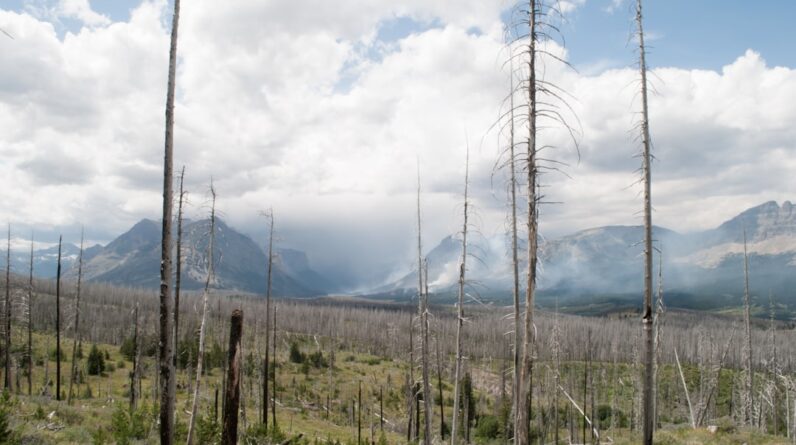
Ecosystem restoration plays a pivotal role in reforestation efforts, serving as a bridge between the past and the future of our natural landscapes. When you think about reforestation, it’s easy to focus solely on planting trees. However, the process is much more intricate and involves reviving entire ecosystems that have been degraded or destroyed.
By restoring ecosystems, you are not just planting trees; you are reinstating the complex web of life that supports those trees and the myriad species that depend on them. This holistic approach ensures that the newly planted trees can thrive in a balanced environment, which is essential for their long-term survival. Moreover, ecosystem restoration encompasses a variety of practices aimed at rehabilitating the land and its natural processes.
This can include removing invasive species, reintroducing native flora and fauna, and improving soil health. As you engage in these activities, you contribute to creating a resilient ecosystem that can withstand environmental changes and pressures. The synergy between reforestation and ecosystem restoration is crucial; without restoring the underlying ecosystem, your efforts in planting trees may yield limited success.
Thus, understanding this relationship is vital for anyone interested in making a meaningful impact on our planet’s health.
Key Takeaways
- Ecosystem restoration plays a crucial role in reforestation by restoring natural habitats and promoting biodiversity.
- Ecosystem restoration has a positive impact on biodiversity by creating healthy and diverse ecosystems for various species to thrive.
- Ecosystem restoration contributes to climate change mitigation by sequestering carbon and reducing greenhouse gas emissions.
- Ecosystem restoration is important for soil health as it helps to prevent erosion, improve soil fertility, and promote sustainable land use.
- Ecosystem restoration plays a key role in water conservation by protecting watersheds, improving water quality, and maintaining healthy aquatic ecosystems.
The Impact of Ecosystem Restoration on Biodiversity
Biodiversity is the cornerstone of healthy ecosystems, and ecosystem restoration significantly enhances it. When you restore an ecosystem, you create a habitat that supports a wide range of species, from the smallest microorganisms to large mammals. This increase in biodiversity is not merely a numbers game; it leads to more resilient ecosystems that can better withstand environmental stressors such as climate change, disease, and habitat loss.
By fostering biodiversity through restoration efforts, you are essentially creating a safety net for various species, ensuring their survival and promoting ecological balance. Furthermore, the restoration of ecosystems often involves reintroducing native species that have been lost due to human activities. This process not only helps to restore the natural balance but also enriches the genetic diversity within those populations.
As you participate in these restoration projects, you contribute to a more vibrant and diverse ecological community. The benefits extend beyond just the flora and fauna; increased biodiversity can lead to improved ecosystem services such as pollination, pest control, and nutrient cycling, which are essential for human well-being as well.
The Contribution of Ecosystem Restoration to Climate Change Mitigation

Ecosystem restoration is a powerful tool in the fight against climate change. As you engage in reforestation and restoration efforts, you are actively contributing to carbon sequestration—the process by which trees and plants absorb carbon dioxide from the atmosphere. Forests act as carbon sinks, storing significant amounts of carbon in their biomass and soil.
By restoring degraded lands and planting new forests, you help to mitigate climate change by reducing the concentration of greenhouse gases in the atmosphere. In addition to carbon sequestration, restored ecosystems can enhance resilience against climate impacts. Healthy ecosystems are better equipped to adapt to changing conditions, such as increased temperatures and altered precipitation patterns.
When you restore an ecosystem, you not only help sequester carbon but also create environments that can buffer communities against climate-related disasters like floods and droughts. This dual benefit underscores the importance of ecosystem restoration as a climate change mitigation strategy that can yield both immediate and long-term advantages for the planet.
The Importance of Ecosystem Restoration for Soil Health
Soil health is fundamental to the success of any reforestation effort, and ecosystem restoration plays a crucial role in enhancing it. Healthy soil is rich in organic matter, nutrients, and microorganisms that support plant growth. When you engage in ecosystem restoration, you often focus on improving soil quality through practices such as adding organic matter, reducing compaction, and promoting biodiversity within the soil itself.
These actions create a thriving environment for plants to grow, ensuring that your reforestation efforts are sustainable. Moreover, restored ecosystems contribute to soil erosion prevention and water retention. Healthy soils can absorb and retain water more effectively, reducing runoff and promoting groundwater recharge.
As you work on restoring ecosystems, you help create a landscape that not only supports tree growth but also enhances overall soil health. This interconnectedness between soil health and ecosystem restoration highlights the importance of viewing these efforts as part of a larger ecological framework rather than isolated actions.
Ecosystem Restoration and Water Conservation
Water is an essential resource for all life forms, and ecosystem restoration plays a significant role in conserving this precious commodity. When you restore ecosystems such as wetlands or riparian zones, you enhance their ability to filter water, regulate flow, and maintain water quality. These restored areas act as natural sponges, absorbing excess rainfall and releasing it slowly into surrounding areas.
This process not only helps prevent flooding but also ensures that water is available during dry periods. Additionally, healthy ecosystems contribute to maintaining the hydrological cycle by promoting groundwater recharge and reducing evaporation rates. As you participate in restoration projects aimed at improving water conservation, you are directly impacting local water supplies and contributing to the resilience of communities that depend on these resources.
The relationship between ecosystem restoration and water conservation is vital for sustainable development, especially in regions facing water scarcity or degradation.
The Role of Ecosystem Restoration in Supporting Indigenous Communities

Ecosystem restoration is not just an environmental endeavor; it also has profound social implications, particularly for Indigenous communities. Many Indigenous peoples have deep-rooted connections to their ancestral lands and rely on healthy ecosystems for their cultural practices, livelihoods, and well-being. When you engage in ecosystem restoration efforts that involve Indigenous knowledge and practices, you honor their relationship with the land while promoting biodiversity and sustainability.
Moreover, involving Indigenous communities in restoration projects can lead to more effective outcomes. Their traditional ecological knowledge often provides valuable insights into local ecosystems that can enhance restoration strategies. By collaborating with Indigenous peoples, you not only support their rights but also ensure that restoration efforts are culturally relevant and ecologically sound.
This partnership fosters a sense of ownership among Indigenous communities, empowering them to take an active role in managing their resources sustainably.
The Economic Benefits of Ecosystem Restoration in Reforestation Efforts
Ecosystem restoration offers numerous economic benefits that extend beyond environmental improvements. When you invest in reforestation projects that incorporate ecosystem restoration practices, you create job opportunities in various sectors such as forestry, agriculture, and conservation. These jobs can range from planting trees to monitoring ecosystem health, providing livelihoods for local communities while contributing to environmental sustainability.
Additionally, restored ecosystems can enhance local economies by promoting ecotourism and recreational activities. As natural landscapes are revitalized, they attract visitors who seek outdoor experiences such as hiking, birdwatching, or camping. This influx of tourism can provide significant economic boosts to local communities while raising awareness about the importance of conservation efforts.
By recognizing the economic potential of ecosystem restoration alongside its environmental benefits, you can advocate for policies that support sustainable development initiatives.
The Future of Ecosystem Restoration in Reforestation Initiatives
Looking ahead, the future of ecosystem restoration in reforestation initiatives appears promising yet challenging. As awareness grows about the importance of restoring ecosystems for both environmental health and human well-being, more organizations and governments are prioritizing these efforts. However, challenges such as funding limitations, land-use conflicts, and climate change impacts must be addressed to ensure successful outcomes.
As you consider your role in this future landscape, it’s essential to stay informed about innovative practices and technologies that can enhance restoration efforts. Advances in remote sensing technology, genetic research for plant resilience, and community engagement strategies are just a few areas where progress is being made. By actively participating in discussions around these developments and advocating for sustainable practices within your community or organization, you can contribute to shaping a future where ecosystem restoration becomes an integral part of reforestation initiatives worldwide.
In conclusion, ecosystem restoration is a multifaceted approach that significantly enhances reforestation efforts across various dimensions—biodiversity enhancement, climate change mitigation, soil health improvement, water conservation, support for Indigenous communities, economic benefits, and future sustainability. By understanding these interconnected roles and actively participating in restoration initiatives, you can make a meaningful impact on both local ecosystems and global environmental challenges.
In addition to understanding the importance of ecosystem restoration in reforestation efforts, it is also crucial to recognize the advantages of planting trees for climate change. This related article discusses how planting trees can help combat climate change by absorbing carbon dioxide and providing essential habitats for wildlife. To learn more about this topic, visit Advantages of Planting Trees for Climate Change. For more insightful articles on environmental conservation and sustainable living, check out the blog section on Live Life with a Cause. Embracing a purpose-driven life that includes environmental stewardship is essential for creating a better world for future generations. Learn more about living life with purpose and making a positive impact on the planet by visiting Live Life with Purpose: Good Purpose.
FAQs
What is ecosystem restoration?
Ecosystem restoration is the process of repairing and restoring damaged or degraded ecosystems to a more natural and functional state. This can involve a range of activities, such as reforestation, habitat restoration, and reintroduction of native species.
Why is ecosystem restoration important in reforestation efforts?
Ecosystem restoration is important in reforestation efforts because it helps to create a more diverse and resilient ecosystem. By restoring the natural balance of plant and animal species, ecosystem restoration can help to improve soil health, water quality, and overall ecosystem function.
What are the benefits of ecosystem restoration in reforestation?
The benefits of ecosystem restoration in reforestation efforts include improved biodiversity, enhanced ecosystem services such as carbon sequestration and water regulation, and increased resilience to environmental stressors such as climate change and invasive species.
What are some examples of ecosystem restoration activities in reforestation efforts?
Examples of ecosystem restoration activities in reforestation efforts include planting native tree species, removing invasive plants, restoring wetlands and riparian areas, and reintroducing native wildlife species.
How can individuals and organizations contribute to ecosystem restoration in reforestation efforts?
Individuals and organizations can contribute to ecosystem restoration in reforestation efforts by participating in tree planting initiatives, supporting habitat restoration projects, and advocating for policies that promote ecosystem restoration and conservation.





